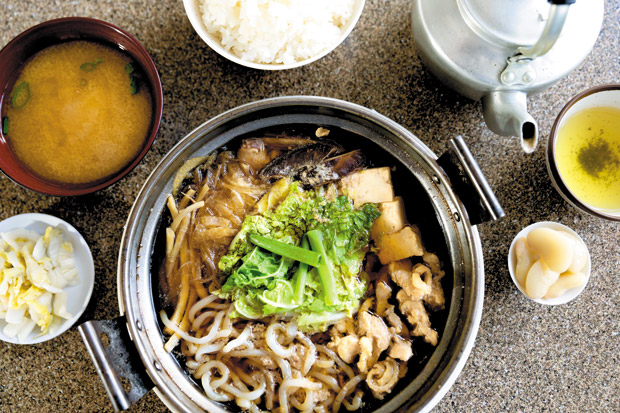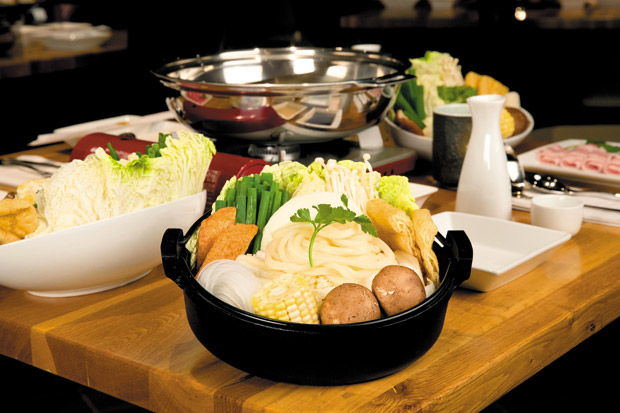Take a look at any hot-pot eatery around town, and you’ll find its tables full — and usually a line out the door — of patrons ready to cook their favorite ingredients within large, communal pots of bubbling-hot broths.
It’s easy to see that this dining trend will continue to sizzle, especially with the variety of hot-pot options available — take your pick from Japanese shabu shabu and nabe to an endless array of Taiwanese, Mongolian and even fusion soup bases. For me, though, there’s one tradition in this department that reigns supreme, and that’s the soothing simmer of sukiyaki.
The specialty dish follows in Japan’s long tradition of mastering the delicate balance of salty and sweet flavors, just the right combination to make it truly irresistible. Most commonly served in large, shallow pots, sukiyaki gains richness from a hearty host of meats and vegetables that cook away to wholesome goodness in a sweetened shoyu broth.
To fulfill my current cravings for sukiyaki — and, hopefully, pass them on to you — I’ve ventured to one of Honolulu’s newest hot-pot havens. Along the way, I also discovered that hot pot-style is not the only way to enjoy sukiyaki. Let me show you what I mean:
FLAVORS THAT NEVER GO OUT OF STYLE
There’s a saying that goes, if it ain’t broke, don’t fix it. This formula applies to the menu of Japanese and local comfort foods at Sekiya’s Restaurant & Delicatessen, which has remained largely unchanged for the past eight decades.
One such recipe that has stayed the same “forever,” according to the staff, is Sukiyaki ($16.95) served up with a choice of beef, pork or chicken (the latter being the most popular). And as I hinted at earlier, this dish — though reminiscent of hot pot — requires no cooking at the table. It’s served hot and ready to devour, so all that’s left to do is dig into an array of onions, makina (Chinese cabbage), gobo, shiitake mushrooms and more.
Part of what has kept customers coming back year after year for this entree is its delectable sukiyaki broth, at the heart of which is the same house-made dashi base that goes into Sekiya’s iconic saimin. It’s mixed with a lovely mingling of shoyu and sugar for an unforgettable slurp, and it gets even better when absorbed by the tofu and ito konnyaku (yam noodles) that round out the dish.
“There’s a lot of variety and components to our Sukiyaki, ” says manager Trey Paresa, “so you can pick and choose all your favorite flavors.”
Though the soup is satisfying on its own, customers receive the added value of rice, miso soup, tsukemono and hot tea with their meal. Paresa notes that patrons also may upgrade to Sukiyaki Udon for $1 more. “Instead of the yam noodle, we put udon inside,” he explains. “That one comes with watercress and a poached egg right on top.”
Speaking of recipes that last a lifetime, Sekiya’s wants readers to know it still offers the shiromame (sweetened beans) that founder Katsuko Sekiya, known affectionately within the family business as Great-grandma Sekiya, used to make back when the eatery was still an okazuya on School Street, before it moved to Kaimuki Avenue in the ’50s. The candy-like beans are the perfect after-sukiyaki treat.
Sekiya’s Restaurant & Delicatessen
2746 Kaimuki Ave., Kaimuki
732-1656
Honolulu, HI 96816
PUTTING THE ‘HOT’ IN HOT-POT
For those in the mood to try sukiyaki served up hot pot-style, I have just the spot for you. Umami-ya Shabu Shabu is Honolulu’s new dining oasis that offers hot pot like you’ve never had it before: in an upscale setting and complete with a fusion of Asian cuisines.
As director of marketing Angela Choi explains, the restaurant’s fare can be described as “70 percent Japanese, 20 percent Korean and 10 percent local.” This holds true for its Sukiyaki, as the rich, sauce-like broth “is Korean-inspired with sesame oil, but Japanese in taste, so it’s on the sweeter side,” she says.
Each patron receives his or her own portion of aburaage tofu, fishcake and veggies galore — won bok, green and round onions, kabocha, corn, and enoki and cremini mushrooms — to cook up on tabletop grills. Udon and glass noodles ensure you don’t leave hungry, while Korean rice cakes give fusion flair to sukiyaki-enthusiasts.
One of the best parts of any hot-pot dish is allowing your meat or seafood to add depth of flavor to the broth as it boils away. The star of Umami-ya’s Sukiyaki, then, is its protein selection, as diners may choose from five savory options: USDA Choice ($25) or Prime ($29) Ribeye, Wagyu New York steak ($39), Kurobuta pork belly ($25), or a seafood medley ($39) of half a Maine lobster, prawns, clams and squid.
“In traditional sukiyaki, the meat comes inside, but in ours, the meat comes separately so you can cook it separately (to your liking),” describes Choi.
You can also upgrade to a five-course dinner set for an additional $10, and if you want to take this meal one step further, dip your cooked ingredients into raw egg on the side — as Japanese tradition calls for. You’ll find the yolk flavor balances out the sweetness of the sauce, while the silky texture of the egg is luxurious to the tongue.
Since opening nightly for dinner in March, Umami-ya has been attracting critical acclaim, so Choi recommends making a reservation, especially if you plan to come in during the weekend.
Umami-ya Shabu Shabu
550 N. Nimitz Hwy., Honolulu
367-1388
Honolulu, HI 96817
See more articles from: Sekiya's Restaurant, Umami-ya Shabu Shabu




